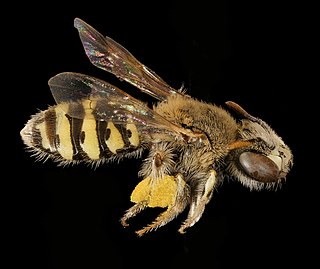Related Research Articles

Halictidae is the second-largest family of bees with nearly 4,500 species. Halictid species are an extremely diverse group that can vary greatly in appearance. These bees occur all over the world and are found on every continent except Antarctica. Usually dark-colored and often metallic, halictids are found in various sizes, colors and patterns. Several species are all or partly green and a few are red, purple, or blue. A number of them have yellow markings, especially the males, which commonly have yellow faces, a pattern widespread among the various families of bees. The family is one of many with short tongues and is best distinguished by the arcuate basal vein found on the wing. Females in this family tend to be larger than the males.

The hawthorn miner bee is a species of miner bee in the family Andrenidae which is in the order Hymenoptera. Another common name for this species is hawthorn andrena. It is found in North America.
Colletes simulans is a species in the family Colletidae, in the order Hymenoptera. The species is known generally as the "spine-shouldered cellophane bee". It is found in North America.

Andrena krigiana is a species in the family Andrenidae, in the order Hymenoptera. The species is known generally as the "dwarf-dandelion andrena". It is found in North America.
Stictiella formosa is a species in the order Hymenoptera, in the class Insecta ("insects"). The distribution range of Stictiella formosa includes Central America and North America.

Eremnophila aureonotata, also known as the gold-marked thread-waisted wasp, is a species in the family Sphecidae, in the order Hymenoptera.
Triepeolus grandis is a species of cuckoo bees in the family Apidae. It is found in Central America and North America.

Triepeolus is a genus of cuckoo bees in the family Apidae. There are at least 140 described species in Triepeolus. The majority of species whose life history is known are kleptoparasitic in the nests of bees in the tribe Eucerini, especially the genera Melissodes and Svastra.

Calliopsini is a tribe of mining bees in the family Andrenidae. There are at least 120 described species in Calliopsini.

Bombus vandykei, the Van Dyke's bumble bee, is a species of bumble bees in the family Apidae. It is found in North America.
Neopasites fulviventris is a species of cuckoo bee in the family Apidae. It is found in North America.
Neopasites is a genus of cuckoo bees in the family Apidae. There are about 5 described species in Neopasites.

Biastini is a tribe of cuckoo bees in the family Apidae. There are at least 3 genera and about 12 described species in Biastini.
Triepeolus rufithorax is a species of cuckoo bee in the family Apidae. It is found in North America.
Lasioglossum petrellum is a species of sweat bee in the family Halictidae.
Habropoda pallida, known generally as the pallid habropoda or white-faced bee, is a species of anthophorine bee in the family Apidae. It is found in Central America and North America.
Lasioglossum tuolumnense is a species of sweat bee in the family Halictidae.

Dufourea monardae, the monarda dufourea, is a species of sweat bee in the family Halictidae. It is found in North America. It is an oligolectic bee on bee balm plants.

Dufourea is a genus of sweat bees in the family Halictidae. There are at least 160 described species in Dufourea.
Lasioglossum olympiae is a species of sweat bee in the family Halictidae.
References
- ↑ "Lasioglossum pilosum Species Information". BugGuide.net. Retrieved 27 January 2018.
- ↑ "Lasioglossum pilosum Report". Integrated Taxonomic Information System. Retrieved 27 January 2018.
- ↑ Sharkey M.J. (2007). Phylogeny and Classification of Hymenoptera.
- ↑ "Phylogenetic relationships among superfamilies of Hymenoptera", Sharkey M.J., Carpenter J.M., Vilhelmsen L., et al. 2012. Cladistics 28(1): 80-112.
- ↑ Heller, Sarah; Joshi, Neelendra; Leslie, Timothy; Rajotte, Edwin; Biddinger, David (2019). "Diversified Floral Resource Plantings Support Bee Communities after Apple Bloom in Commercial Orchards". Scientific Reports. 9 (1): 17232. Bibcode:2019NatSR...917232H. doi:10.1038/s41598-019-52601-y. PMC 6872784 . PMID 31754173.